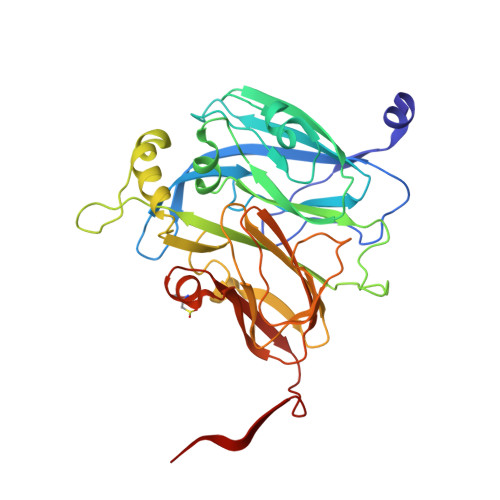Directed evolution of copper nitrite reductase to a chromogenic reductant.
Macpherson, I.S., Rosell, F.I., Scofield, M., Mauk, A.G., Murphy, M.E.(2010) Protein Eng Des Sel 23: 137-145
- PubMed: 20083495
- DOI: https://doi.org/10.1093/protein/gzp084
- Primary Citation of Related Structures:
3H4F, 3H4H, 3H56 - PubMed Abstract:
Directed evolution methods were developed for Cu-containing nitrite reductase (NiR) from Alcaligenes faecalis S-6. The PCR cloning strategy allows for the efficient production of libraries of 100 000 clones by a modification of a megaprimer-based whole-plasmid synthesis reaction. The high-throughput screen includes colony lift onto a nylon membrane and subsequent lysis of NiR-expressing colonies in the presence of Cu(2+) ions for copper incorporation into intracellularly expressed NiR. Addition of a chromogenic substrate, 3, 3'-diaminobenzidine (DAB), results in deposition of red, insoluble color at the site of oxidation by functional NiR. Twenty-thousand random variants of NiR were screened for improved function with DAB as a reductant, and five variants were identified. These variants were shuffled and screened, yielding two double variants. An analog of the DAB substrate, o-dianisidine, which is oxidized to a water-soluble product was used for functional characterization. The double variant M150L/F312C was most proficient at o-dianisidine oxidation with dioxygen as the electron acceptor (5.5X wt), and the M150L single variant was most proficient at o-dianisidine oxidation with nitrite as the electron acceptor (8.5X wt). The library generation and screening method can be employed for evolving new reductase functions in NiR and for screening of efficient folding of engineered NiRs.
Organizational Affiliation:
Department of Biochemistry and Molecular Biology, University of British Columbia, Vancouver, Canada.
















